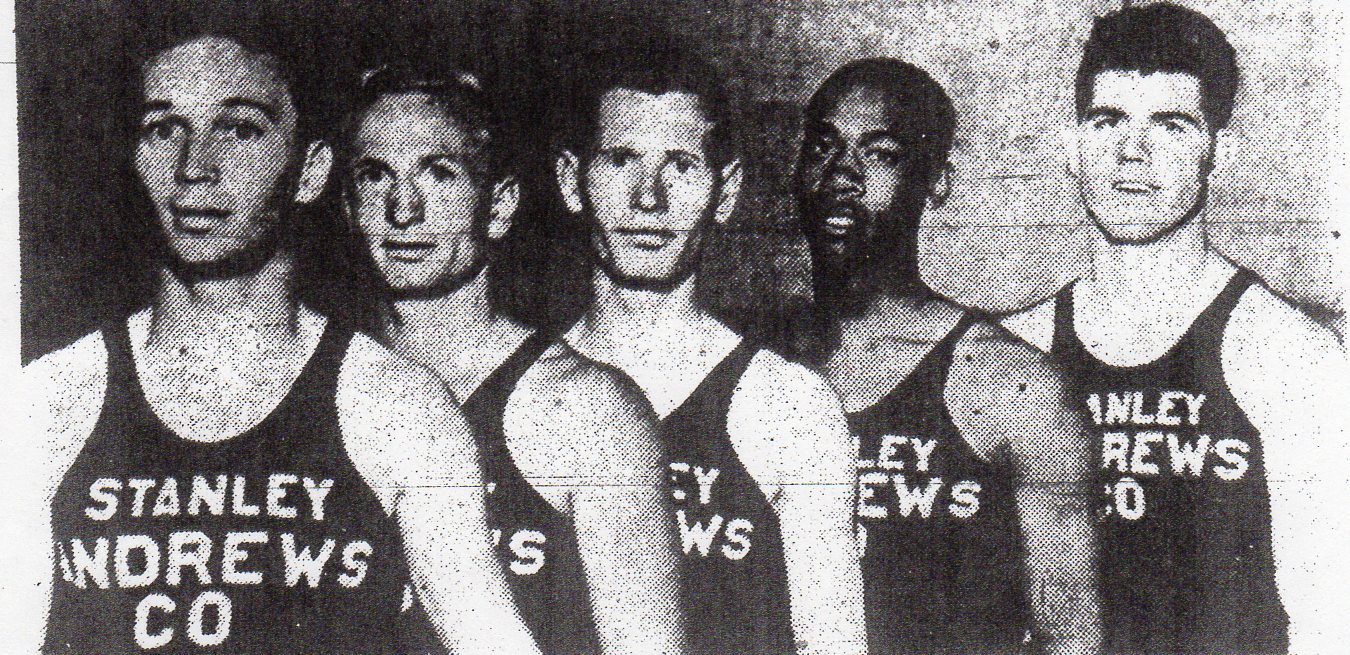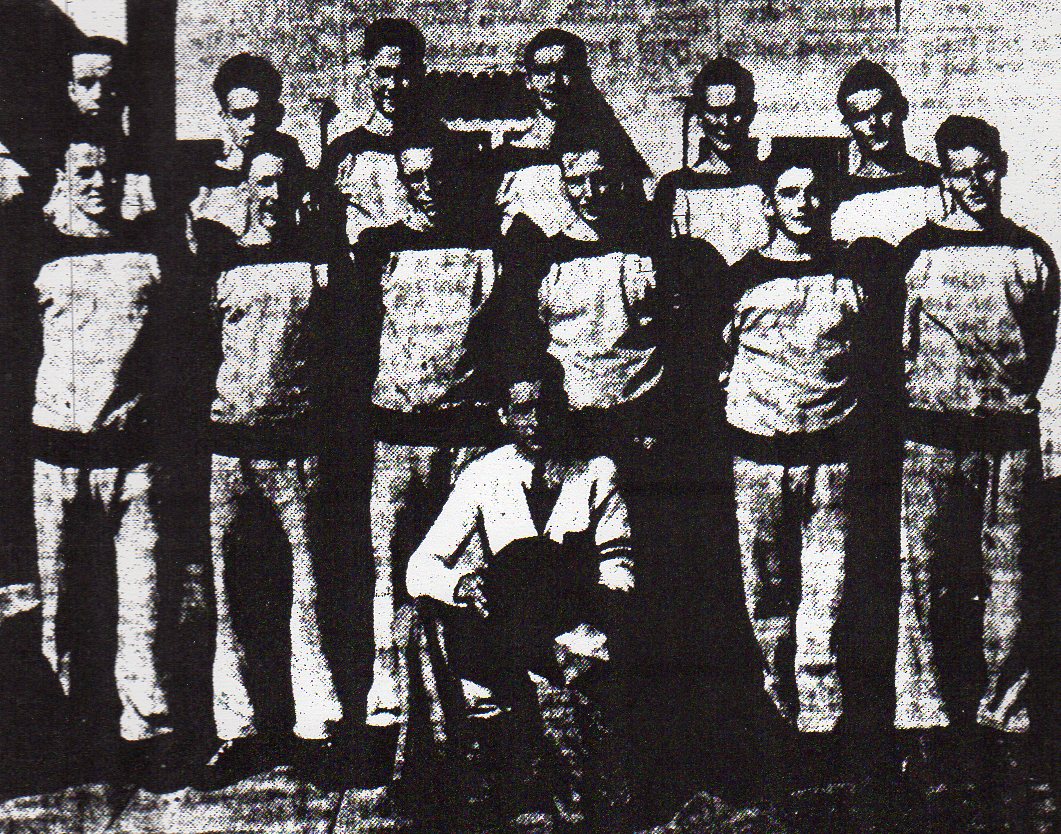Class B teams were not junior varsities and not necessarily inferior to Class A (varsity) clubs.
The B designation was based on exponents, which combined height, weight, and age. It was not unusual for seniors to play on B squads.
Under Coach Bruce Maxwell, Hoover ruled the B world, many times playing the feature, late game of a doubleheader with the Class A Cardinals team on the undercard.
The Hoover Bees had won CIF Southern Section titles in 1931-32, 1933-34, and 1934-35.

The Cardinals were at least even money to also win in 1935-36, but no championship game was contested because their South Pasadena opponent refused to play (search 1935-36, “Hilltoppers Win, Cardinals’ Feathers Ruffled”).
CIF honcho Seth Van Patten and his executive board did not call a forfeit on South Pas but declared that there would be no 1935-36 champion, and eliminated Class B playoffs going forward.
BRUCE ALMIGHTY STEPS DOWN
Maxwell now was teaching math at Hoover and was succeeded by Lawrence Carr.
Undefeated since ’33-34, the Bees had won 48 games in a row before stumbling on their home court at San Diego High, 25-21, to the Santa Ana Saints, who came into the game with a 0-3 league record.
Imagine a sway-backed plow horse outrunning Secretariat.
Hoover tied for first with Long Beach Poly in the Coast League and was declared champion because it had beaten the Jackrabbits, but the Cardinals’ days of Class B domination were coming to an end.
MIDSEASON GRADS ROIL COAST
Class A league play in the 6-team Coast League lasted all of 14 days, Jan 12-Jan. 26. Bosses wanted the schedule completed before mid-term graduation, theoretically giving teams time to regroup before the playoffs.
San Diego would lose Freeman Dill, the league’s leading scorer; Roy Falconer, and Homer Peabody, plus two reserves.
Alhambra lost three starters, Long Beach Poly, one. The three teams finished in a tie for first, each with a 4-1 record.
Alhambra beat San Diego, 32-15, but lost to Poly, which San Diego defeated, 25-18.
What followed was an interminable postseason.
PLAYOFF BEFORE PLAYOFFS
A playoff to determine the Coast League entry in the Southern Section playoffs was to begin almost two weeks later. The winner between San Diego and Alhambra would face Long Beach Poly.
The Hilltoppers, under first year coach Ed Ruffa, pulled off a rare double, beating Alhambra, 39-21, on Feb. 6 as erstwhile substitute Al Martinez scored 17 points, and in overtime at Poly, 22-21, Feb 13.
Most other Southern Section Leagues still were involved in their regular seasons.
Two weeks later, on Feb. 24, a scheduled Hilltoppers playoff with Metropolitan League champion Point Loma failed to materialize as the Pointers forfeited.
Point Loma coach Joe Beerkle said that he had lost two starting players, Gil Gonsalves and Gerald Lutes, to midterm graduation and, anyway, the rest of the team was concentrating on the beginning track-and-field season.
WAIT CONTINUES
On Feb. 27, Ruffa was getting desperate for a game, any game.
The San Diego coach lined up one with the Eta Omega Delta fraternity from San Diego State.
No score was reported but the Cavers apparently won handily, behind newcomer Claude Roberts, who scored 16 points.
At about the same time Brawley was defeating Calexico for the desert title and then routed Southern League champion Ramona, 53-18.
ON TO THE SEMIFINALS
A 34-20 win over Brawley on March 5 moved the Hilltoppers into the round of 4 on March 13 at Whittier College against Tustin, which had a 24-4 record.
San Diego battled back from a 19-12 halftime deficit to a tie at 23, but the Tillers behind the Francis brothers, “Pivoting” Paul and “Slinging” Sam, pulled away to a 34-30 victory.
Tustin the next evening defeated Whittier, 34-24, for the championship.
San Diego closed with a 15-5 record that included a 46-day stretch from the end of league play to the semifinal round of the postseason.
SAINTS SOAR

The 14th annual San Diego Interscholastic tournament, with 32 teams competing in 66 games in four days in Class A, B, C, and D divisions, played out as expected, with one exception.
San Diego High won A, C, and D and Hoover B, but St. Augustine got the headlines.
“Nearly one-thousand fans were startled when Biff Gardner’s smooth-passing, straight-shooting Saints created one of the biggest upsets of recent years by defeating Hoover, 22-16,” declared a writer for The San Diego Union.
The quintet of Ed Vitalich, Charlie Strada, Bob Menke, John (Red) Keough, and Evers would go on to post a 13-2 record, best in the area, and lost only to San Diego, 27-20, in the tournament finale and 40-15 later in the season.
The poor, all-boys school in North Park seldom got respect from the media and always was questioned by rivals of operating with much easier rules of athletic eligibility
The Saints rejoiced with this infrequent taste of glory.
TOURING CLASS
Coronado was 4-1 on a six-day visit after Christmas to the University of Redlands Frosh (20-17), San Jacinto (28-9), Long Beach Jordan (20-19), and San Juan Capistrano (27-20), sandwiched around a 25-20 loss at Redlands High.
San Diego coach Ed Ruffa prepared to whistle stop several venues in the Southwest, but received no replies after soliciting El Centro Central, Brawley, Holtville, and Mesa, Arizona. The Hilltoppers still posted wins at Yuma, 32-11, and Phoenix Union, 31-22.
FUTURE BOSSES

San Diego’s Kenny Hale, played on San Diego State’s 1941 National Association of Intercollegiate Basketball championship squad and was a nine-season head coach at Hoover from 1947-48 through 1951-52, posting a 76-43 record, and at the start-up Mission Bay program, where Hale was 53-44 from 1954-55 through 1957-58.
Alhambra guard Shannon Deniston was better known as Shan when he coached football at La Jolla, Lincoln, and San Diego from 1955-81, posting a 94-81-4 record.
SIGN OF THE TIME
No longer will San Diego State athletes be mistaken for lettermen from Sweetwater, Santa Ana, J.C., or Stanford, wrote Charles Byrne in The San Diego Union.
“An interlocking SD debuted when lettermen from football got their sweaters at a college dance,” said Byrne.
The schools Byrne mentioned also matched Aztec colors of red and black.
“The Aztecs could still be mistaken for the University of South Dakota, but the Coyotes colors are yellow and blue,” said Byrne.
After World War II, San Diego High lettermen apparel featured a singular “S”, but gave way to the interlocking SD in the mid-‘fifties.
TWO-HAND SET SHOTS
When not coaching football, Hoover’s John Perry took his additional football and basketball game officiating assignments a step further…Perry often was third man in the ring on downtown Coliseum boxing cards…rain forced the Grossmont-Sweetwater game indoors to San Diego State…Hoover was forced to move a practice to San Diego High because of muddy courts…Cardinals would take floor after the Hilltoppers finished their practice, for Hoover often at 5 p.m….the 32-15 loss to Alhambra, was San Diego’s most decisive in 38 games, since a 37-17 loss to Long Beach Poly in 1934-35…at least three separate scuffles reportedly broke out in the stands or between players during the teams’ Class B game won by Alhambra, 25-21… Point Loma presented a “basket ball” following its game at San Diego with Coronado…the Pointers also invited the Islanders team to what later would be known as a “sock hop”…games in the San Diego Interscholastic event were played at San Diego High, San Diego State, the downtown YMCA and the Army-Navy Y…Ramona gained the right to play Brawley in the playoffs by defeating Mountain Empire, 31-29, in overtime at San Diego State…Point Loma’s 31-22 win against Sweetwater gave the Pointers an undefeated Metropolitan record, 8-0…coach Harry Wexler’s Escondido Cougars had the reported highest scoring total for the season in a 56-21 win over Coronado…Wexler’s sons, Warren (20 points) and Duncan (7) led the way…San Diego’s Roy Falconer joined Pasadena Muir’s Jackie Robinson and others on the all-Southern California first team…The Hillers’ Freeman Dill was on the second team….

High school track once used the ABC system based on weight, age, size also.
I think it all changed in California in 1967 or ’68. Track teams that I covered for the Evening Tribune had varsity squads and a JV squad, effectively eliminating B’s and C’s. I believe the JV teams also competed in varsity events, i.e., 180-yard low hurdles instead of 120 low hurdles. Thanks for writing.
Rick – That TWO HAND SET SHOT title got my attention. It reminded me of my J.C. friend Albert West. That shot was nearly dead in the fifties, but Albert was still successful in using it. Do you think he may have been the last player locally to use it to any degree? Cheers, John
I saw John Bocko of Hoover drain a couple of those in a game at Lincoln in the 1959-60 season. Don’t remember anyone else before or since. Albert West is Willie’s brother, I think. Great San Diego athletic family.
Yes, Willie’s brother –
Rick,
I thoroughly enjoy your historical posts. I remember looking forward to your Sports coverage when I was playing football in 1963. I now look forward to your current writings via partletonsports.
I have recently been going to lunch with guys I played with on Mesa College’s 1st football team under John Kovac. We’ve had great times remembering the old days.
Thanks for keeping it all alive.
Rick Novak
Hoover
Class of 1964.
Rick Novak
Thsnk you for the nice words, Rick. I remember you as a tall end on one of Roy Engle’s best teams. Didn’t you eventually become principal or vice princial at Hoover? All the best.